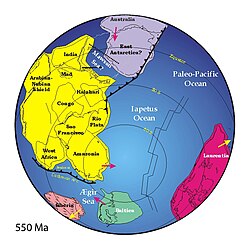Baltica
Appearance

Baltica was a late-Proterozoic, early-Palaeozoic continent that now includes the East European craton of northwestern Eurasia. Baltica was created as an entity not earlier than 1.8 billion years ago[citation needed]. Before this time, the three segments/continents that now compose the East European craton were in different places on the globe. Baltica existed on a tectonic plate called the Baltic Plate.
History
- ~1.8 billion years ago, Baltica was part of the major supercontinent Columbia.
- ~1.5 billion years ago, Baltica along with Arctica and East Antarctica were part of the minor supercontinent Nena.[1]
- ~1.1 billion years ago, Baltica was part of the major supercontinent Rodinia.
- ~750 million years ago, Baltica was part of the minor supercontinent Protolaurasia.
- ~600 million years ago, Baltica was part of the major supercontinent Pannotia.
- ~Cambrian, Baltica was an independent continent.
- ~late Ordovician, Baltica collided with Avalonia (most of modern Western Europe)
- ~Devonian, Baltica collided against Laurentia, forming the minor supercontinent Euramerica.
- ~Permian, all major continents collided against each other to form the major supercontinent Pangaea.
- ~Jurassic, Pangaea rifted into two minor supercontinents, Laurasia and Gondwana. Baltica was part of the minor supercontinent Laurasia.
- ~Cretaceous, Baltica was part of the minor supercontinent Eurasia.
- ~Present, Baltica is part of the forming minor supercontinent Afro-Eurasia.
See also
References
- ^ Carl Zimmer (January 1997). "In Times of Ur". Discover Magazine. Retrieved 2 February 2016.











